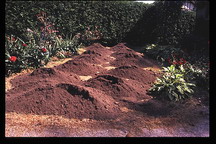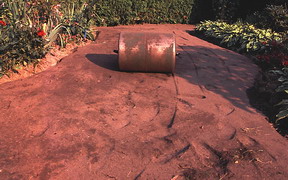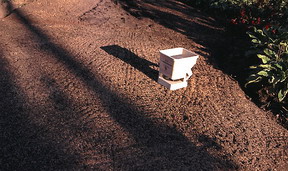|
Grass Seed
|
What Are The Steps?
Destroy, (a great verb for weeds,) the existing vegetation by spraying with a chemical such as Roundup, (Glyphosphate,) that kills everything green that it touches but decomposes on contact with the soil.

The non-chemical approach is to cover the area with black plastic which simply cooks and composts everything under it. In about 2 weeks everything should be dead and you can rototill it. If the dead grass will not break up easily you may have to rake it off and add it to the compost heap. Add 5 – 10 cm (depending on the quality of your existing soil,) of good quality soil (such as triple mix)and then rototill again to mix it in and to give you enough loose soil to easily rake it level.
 Do I Fertilize?
Do I Fertilize?
When you're almost finished raking, apply a granular starter fertilizer, such as 15 30 15. The middle ingredient is phosphorous which encourages root growth. When leveled, roll it with just enough weight to stop your feet leaving noticeable footprints. Now rake again lightly to loosen the surface and to achieve an even smoother finish.
Sod or Grass Seed?
You now have a time and money choice. Sod is quick and expensive. Grass seed is slower and much cheaper and a lot less physical effort. If you choose to seed, you can actually get a better lawn; if you choose high quality grass seed. Sod farms use good quality seed but there is certainly better. You have the 2 weeks while the existing vegetation is dying to do your research. In the spring of 2011 there will be a new variety of grass seed available. RTF water saver is a new variety of tall fescue that I am trialling

How Do I Seed?
Sprinkle the seed on the lightly raked soil at the coverage rate the package recommends. Roll again to make a smooth surface and to get the seed into intimate contact with the soil from which it will draw the moisture that is essential for its germination. You may have to help out Mother Nature by watering lightly, morning and evening, to keep the seed moist. As the seed germinates, and that can take 2-3 weeks, start to water more deeply but less frequently. This will encourage the new little grass plants to penetrate into the soil and become well established.
Sod Is Quicker?
If you choose sod, find out when the nursery receives their fresh supply and show up that day to buy newly cut sod. When you get it home roll out the sod on the lightly raked soil making sure to butt the edges firmly, and then lightly roll the finished area. Water thoroughly, after rolling, and continue to water every 2 -3 days if there is not sufficient rain to penetrate the sod.
That’s all there is to it. Destroy existing, wait 1- 2 weeks, prepare soil, (a good weekend’s workout,) sow grass seed, water and enjoy.
Now if you are an addicted gardener like myself you would use this opportunity to plant a whole mess of little bulbs, like species crocus or bluebells in the soil while it is loose and then seed or sod over them. In the spring the lawn will be filled with little flowers whose leaves will disappear into the lawn as you start cutting it.
Get answers to your gardening questions by subscribing to
Ken’s free newsletter, Dallying In The Dirt
return from Grass Seed to Ken's home page
